Nissan 180SX
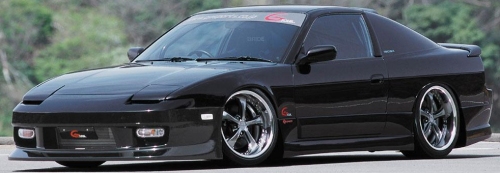
Old school JDM Nissan 180SX drift car.
The Nissan 180SX is a JDM hatchback produced from 1989 to 1998. The Nissan 180SX name comes from the 1.8 liter turbocharged CA18DET engine that originally powered the Japanese car. The 180SX is based on the Nissan S13 Silvia chassis and sold only as the 180SX in Japan. In Europe and South Africa the 180SX sold as the 200SX and in North America the 180SX sold as the 240SX Fastback.

Classic JDM Nissan 180SX drift car.
The 180SX is different from the S13 Silvia because it has pop-up headlamps and a hatchback, know as a Fastback in North America. In 1993 the S13 Silvia was discontinued, but the 180SX was successful enough to continue production until the end of the S14 Silvia generation. Specs and equipment are similar but the naturally aspirated CA18DE engine was not an option, only the turbocharged CA18DET was available.
In Japan, the engine was upgraded to the 2.0 liter SR20DE engine and optional turbocharged SR20DET in 1991; meanwhile, the North American 240SX kept the KA24DE engine.A popular body modification to the 180SX is the Sileighty conversion. A Sileighty, also writen Sil80, is a Nissan 180SX with S13 Silvia headlights, front fenders, hood, and front bumper. The Sileighty style originated with street racers and drifters in Japan who did the conversion after a wreck because the S13 Silvia’s front panels and lights were lighter and cheaper than the 180SX replacement parts.
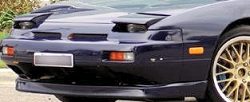
Sleepy eye modified Nissan 180SX. Flip up head lights are modded to open only half way, giving a “Sleepy” look.
The 2007 D1 Street Legal Japan Champion Kazuya Matsukawa drives a Nissan 180SX. In the Japanese anime Initial D, Iketani’s friend and member of the Akina Speedstars Kenji drives a white 180SX. The 180SX is also featured in popular racing video games like Need For Speed and Gran Turismo 2.
Nissan Sileighty
A Sileighty (also written Sil80) is a Nissan 180SX with Nissan S13 Silvia headlights, front fenders, hood, and front bumper installed, hence the “Sil,” short for Silvia, and the “eighty,” for the 180SX. The Sileighty originated in Japan. Street racers and drifters in Japan did this conversion after a wreck because the S13 Silvia’s front panels and lights were lighter and cheaper than the 180SX replacement parts.

Combining the 180SX body with a S14 or S15 Silvia front end is a popular conversion.
In the United States, it has become common for owners of the 240SX, the American version of the Nissan Silvia, to make their own Sileighties by importing a Silvia front end and installing it onto their car. Sometimes this 240SX/Silvia conversion is referred to as a “Silforty,” but most import enthusiasts insist on calling it a Sileighty because the proportions of the 240SX fastback body are identical to the 180SX components aside from labeling. Converted S13 coupes or convertibles are not considered Sileighties, instead, the car is most commonly referred to as a JDM Silvia Conversion.
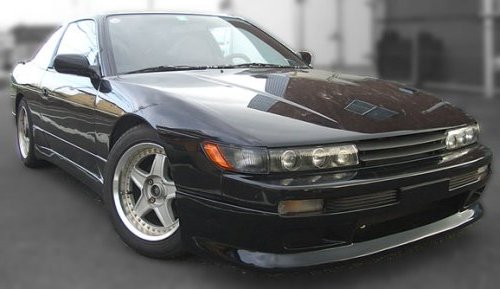
Heavily modified Nissan Silvia S13. Body from S13 and front clip from S14 Silvia.
Another variation is sometimes called the Onevia, which consists of 180SX parts on the front end of a S13 Silvia. Nissan sold a similar configuration in the United States badged as the S13 240SX Coupe due to headlight height regulation. However, to be classified as a true “Onevia,” parts from two vehicles must be combined after manufacture.
Combining the 180SX body with a S15 Silvia front end is a popular conversion. This 180SX/S15 conversion is often known as a “Sil-Fifteen Eighty” or “S13.5.”

Modified Nissan S13 featuring S15 front clip. Common conversion after front end damage.
With the popularity of the 180SX and Silvia conversion, a Japanese auto shop named Kids Heart decided to produce a small number of Nissan Sileighties tuned for drifting. It is on record that 500 cars were made by this shop, and were only sold in 1998. The Kids Heart model Sileighty can be distinguished from their home-built counterparts by the distinctive “Sileighty” name on the rear dress plate and quarter windows. The Kids Heart Sileighty includes drift-oriented modifications such as a new ECU, stiffer suspension, an improved limited slip differential, and an increase in turbocharger boost from 7 psi to about 13 psi, resulting in approximately 230 horsepower, versus 205 horse from the standard 180SX SR20DET engine.
The Sileighty has been featured in anime and video games. In Initial D, the female racing pair Impact Blue drives a Sileighty and in many of the Playstation Gran Turismo games the Sileighty can be purchased or is given as a prize for completing certain goals in the game.
History of the Nissan Silvia
CSP311 (1965 – 1968)
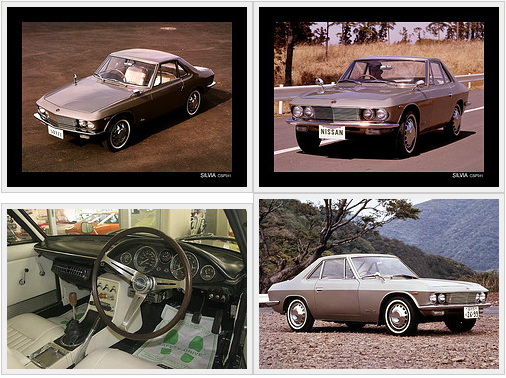
Nissan CSP311.
The Silvia name was first introduced in 1964. The CSP311 Silvia was a hand-built coupe based on the Fairlady convertible, styled with input from Albrecht Goertz. Production ceased in 1968 after a mere 554 were made, every one unique with hand-formed body panels. A majority of exports (49 cars) were sent to Australia while most remained in Japan. The Silvia name was to remain unused until 1974.
S10 (1975)
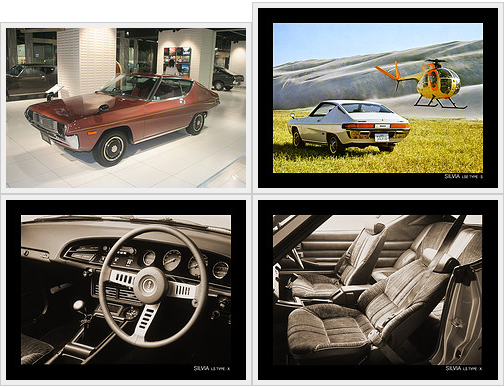
Nissan Silvia S10.
The S10 was the first Silvia built on the S Chassis platform, and featured a sports-coupe shape, as was popular at the time — Unfortunately, it featured more traditional lines than rivals Celica, Capella and others, and was thus less popular, even in Japan. It was available with many luxury features — in Japan it was fitted with an L18B engine, as was fitted to the Datsun 610/Bluebird 180B. In America it was fitted with the same 2 litre variant, the L20B, as the 200B of the same series Bluebird.
The car, as known in America as a 200SX, was unpopular mainly due to the federally-mandated “5 mph” bumpers ruining the intended lines of the car, and also, because America had yet to warm to the idea of a Japanese sports car. Its success in Japan was limited, most buyers opting for Celicas over the more humdrum Silvia.
S110 (1979)
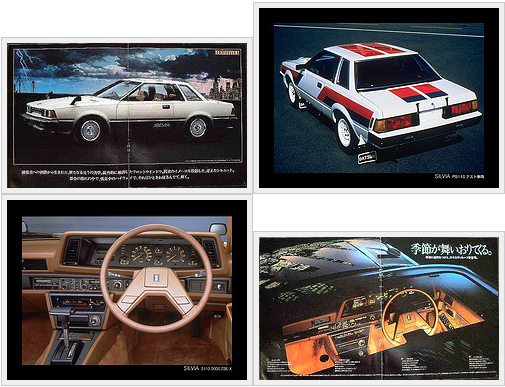
Vintage JDM drifter Nissan Silvia S110.
The S110 was the next in the chain. This Silvia was unusual because it was originally intended to feature a rotary engine, designed and built by Nissan. This engine however was fairly unreliable, and forestalled production. Ironically it shared a chassis code with the also ill-fated Mazda Cosmo, first Japanese production car to feature a rotary engine.
This generation saw the debut of the “Gazelle” name, used for the luxury models of the S110. It was redesigned shortly after it was originally released, the rotary replaced by several piston engines for different markets, most based around the new Z-series engine, including the Z20, and the turbocharged and fuel injected Z18ET. It was not the most powerful though — the Silvia 240RS was a notchback S110 fitted with a 2.4 litre, DOHC, FJ24 engine, built between 1983 and 1985, past the end of production for the S110 itself. The 240RS was Nissan’s official rally car in 1983-1985 World Rally Championship. The Silvia’s best finish was 2nd, in the 1983 New Zealand Rally.
S12 (1983)

Nissan Silvia S12 model drift car.
The S12 platform was produced from late 1983 to early 1988. This new series saw the debut of the CA-series engine, as well as pop-up headlamps. US and Canadian models were still all known as “200SX” even though displacement varied from 1.8L (the CA18ET turbocharged engine, only available in the fastback body style, 1984-1986, -1988 in Canada), to 2.0L (the CA20E, available in all models and all years), and 3.0L (the VG30E V6, available only in the SE-V6 fastback in the US in 1987-1988).
In Australia, Europe, and Japan, quite a few different engines were available. The CA20E was available in all of these areas throughout the entire production run. Both a coupe and a hatchback were available in these markets. 1984-1988 hatchbacks were available with any engine offered in the given area (FJ20E, FJ20ET, CA20E, CA18ET) but the Coupe was only available with the CA20E, except for the RS-X version which came with the FJ20ET. The FJ20ET and the FJ20E are dual cam motors (this is not denoted in the engine code, unlike later Nissan engine series). The 1988 Japanese RS-X was equipped with a CA18DET in place of the previous FJ20ET.
S13 (1988)

Nissan Silvia S13 model drift car.
The S13 Silvia, introduced in mid-1988 for the 1989 model year, was immensely popular in Japan. The Silvia name was no longer used on export models, however; European models were now known as 200SX. Following industry trends, the S13 Silvia switched to relampable fixed headlights. Projector optics were offered as an option.
The Silvia fastback was discontinued, replaced by a new model, the Nissan 180SX. This left only the notchback coupe. A convertible was briefly offered soon after the start of production, but it was never popular, perhaps due to high cost – 3.25 million Yen in 1988 ($27,500 USD).
The S13 was one of the first uses of Nissan’s multi-link rear suspension, the technology of which was previewed in concept cars in previous years, such as the Nissan MID-4. It also offered a four-wheel steering system for the first time, known as HICAS-II. In 1990, HICAS-II would be updated and renamed SuperHICAS. The S13 also saw the introduction of a viscous-type limited slip differential (LSD) for some models.
S13 Silvias were initially powered by the CA18DE and CA18DET engines carried over from the end of S12 production, with an intercooler added to the CA18DET for a slight increase in power. In 1990, for the 1991 model year, the SR20DE and SR20DET engines debuted, offering improvements across the board in power and torque, due to increased displacement and a more efficient turbocharger than the CA.
The S13 Silvia was discontinued after the 1993 model year, in favor of the new S14 chassis design. In 1998, the S13 Silvia was resurrected. A variant was produced by Kid’s Heart for Nissan called the Sileighty, which featured the 180SX body with the front end from the Silvia. The Sileighty style was originally created by Japanese enthusiasts for their own 180SXs, and is still a common modification for the 180SX and 240SX fastback.
The S13 Silvia was the first S-series car to use the J’s (Jack’s), Q’s (Queen’s), K’s (King’s) naming for the different trim levels. The J’s was the base model with a very basic interior, little standard equipment, and 14″ steel wheels. The Q’s model is middle-of-the-line. They received many electric options and an optional LSD. The K’s received the turbocharged engines, along with all the upgrades of the Q’s.
On top of the K’s and Q’s models, The Club Selection and Dia(mond) Selection packages came with specific options bundled together; for example, all K’s Club Selections came with projector headlights, a rear spoiler, and aluminum wheels. All the names used are references to the suits and face cards of English playing cards.
There also exists the rare Silvia A’s “Almighty” (オールマイティ), introduced in late 1992. Confusingly, the Almighty fits roughly into the middle of the range. The only available engine was the naturally-aspirated SR20DE.
S14 (1993)
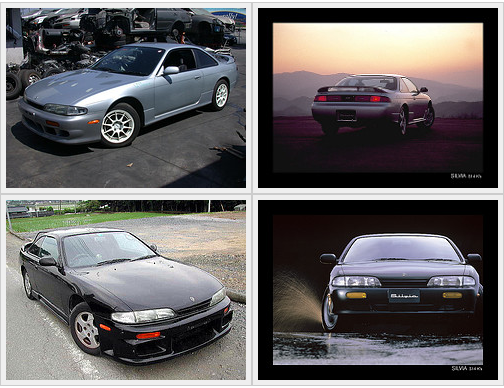
Nissan Silvia S14 generation drift car.
The S14 Silvia debuted in Japan at the end of 1993. It was lower, wider, and slightly shorter than the S13. New rounded styling contributed to the illusion of a much greater increase in size than actually occurred. Wheelbase and track were both increased slightly, leading to slightly improved handling. Unlike export markets, where local S14 chassis variants faltered, the Silvia remained popular in Japan.
Model names were similar to the S13 Silvia, with the Club Selection dropped. “Aero” variants of the Q’s and K’s were offered that featured large rear wings and mild ground effects.
The S14 Silvia K’s received a new “notchtop” version of the SR20DET, boasting a slight bump in power due to the implementation of Nissan’s variable cam timing system, VTC, and a more efficient ball bearing turbocharger.
There was a mild styling update to the S14 for model year 1997, which added aggressive projector headlamps to all models, and dark-tinted tail lights. Fascias and other trim were also revised. This updated version is popularly known as the kouki (後期, literally “latter period”) S14, or it is sometimes called the S14a. The final model year of S14 production in all markets was 1998.
S15 (1999)

Nissan Silvia S15 high performance drift car.
Japan saw a new version of the Silvia (S15) in 1999, now boasting 250 hp (184 kW) from its SR20DET, engine thanks to a slight turbocharger upgrade, as well as improved engine management. The SR20DE (non-turbo motor) featured only 165 hp (121 kW).
The S15 Silvia included aggressive styling inside and out; upgrades to the chassis and suspension, including increased use of light alloy suspension components; and for the first time, a six-speed manual transmission (in addition to a 5-speed manual transmission and a four-speed automatic). Also for the first time, instead of a viscous limited slip differential, the S15 offered a more effective helical limited slip unit.
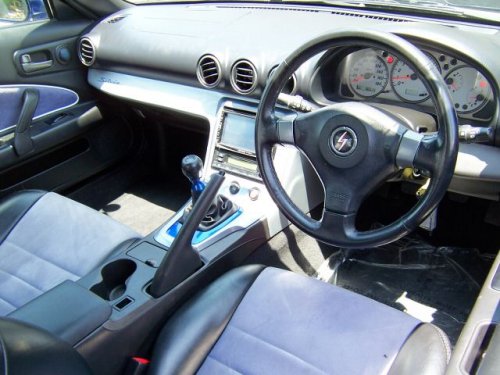
Nissan Silvia S15 drift car driver side right hand drive interior view.
For the S15 Silvia, the model lineup was initially simplified to just the Spec-S (non-turbo) and Spec-R (turbo), both models offering an “Aero” variant with a large rear wing and mild ground effects. The Spec-R featured the available 6-speed manual transmission, increased body and suspension rigidity, 4-piston front brake calipers, a larger brake power booster, the upgraded helical limited slip differential, and HICAS (High Capacity Active Steering) four wheel steering as an option; the Spec-S featured only a 5-speed manual transmission (in addition to a 4-speed automatic available on both the Spec-S and the Spec-R), lacks the additional support structures of the Spec-R, 2-piston front brake calipers, a slightly smaller brake power booster, and the viscous limited slip differential (LSD).
The line was later expanded to include various luxury and upgrade option packages for both the Spec-S and Spec-R. Autech, Nissan’s special-car division, also offered several tuned versions of the S15; one with body and interior trim modeled after the Ferrari 456, called the style-A, available in both Spec-S and Spec-R based trims; and a second tuned version was based of the Spec-S trim level with the engine output increased to 200 hp through the use of increased compression, more aggressive camshafts, and free-breathing intake and exhaust tracts, along with ECU tuning and upgrades to the chassis and suspension. This version also included the 6-speed transmission and other upgrades normally found only in the Spec-R.

Beautiful coral Nissan Silvia S15 drift car.
There was also a convertible variant of the Silvia, called the Varietta, featuring a folding retractable hardtop. The Varietta was built by Autech and was based off of the Spec-S model, featuring the same naturally aspirated engine, with a choice of the 4-speed automatic transmission or the 5-speed manual transmission.
Production of the Silvia ended in August of 2002 amidst Nissan’s efforts to reduce its myriad of platforms. Nissan’s sole sports car platform in the world is now the FM Platform, which is used in the current Fairlady Z and Skyline, and America’s 350Z and Infiniti G35.
Nissan SR20DET Engine
The Nissan SR20DET is a popular 4-cylinder JDM engine known for being the heart of the Nissan 180SX and Silvia. SR20DET engine swaps are popular in North America for 240SX owners.
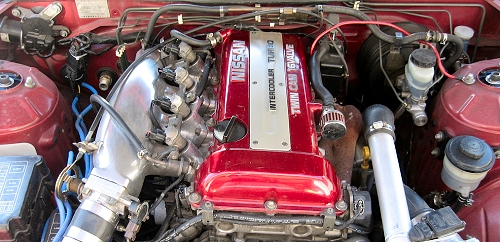
Nissan SR20DET engine and heartbeat of the Silvia drift car.
Nissan SR20DET engine code explained:
SR – Engine Family
20 – 2.0 Liters Displacement
D – Dual Overhead Cam
E – Electronic Fuel Injection
T – Turbocharged
Nissan also produced a cheaper naturally aspirated (non-turbo) version of the SR engine called the SR20DE. The SR20DET engine replaced the CA18DET that originally powered the Silvia and 180SX. Different variants of the SR20DET engine have different color valve covers.
- Red Top SR20DET (1989-1994) S13 Silvia, 180SX, Pulsar, Bluebird
- Black Top SR20DET (1994-1998) S13 Silvia, 180SX
- Black Top SR20DET (1994-2002) S14 Silvia, S15 Silvia
- Silver Top SR20DET (1995-2001) Avenir

SR20DET engine found in the Nissan Silvia drift car.
The SR20DET engine was first used in 1989 in the U12 Nissan Bluebird 2000SSS Attesa. From 1990 to 1994 the SR20DET was used in the Nissan Pulsar GTi-R (N14) but with a larger Garret T28 turbocharger. In both cars the engine is mounted in an East/West fashion but in the Silvia and 180SX the SR engine is mounted North/South.
Then the SR20DET engine was used in the Nissan Avenir in 1995, the Nissan R’nessa in 1997, and the Nissan Liberty in 1999. The S14 and S15 Silvia use a larger Garrett T28 turbocharger. The S15 Nissan Silvia Spec R trim level SR20DET uses a T28 Garret turbocharger with a dual ball-bearing center cartridge compared to the ceramic center cartridge present in the S14 Silvia. The Nissan Silvia was the longest running model to use the SR20DET engine.
Nissan Skyline R32 GT-R

R32 Nissan Skyline GT-R racing on a road course.
After canceling the Skyline GT-R in 1973, Nissan revived the GT-R name in 1989. Nismo, or Nissan Motorsport International, originally designed the new R32 GT-R Skyline to have a 2350 cc straight six turbocharged engine, and produce 600 horsepower using a RWD drivetrain. Under Group A regulations, a turbocharged engine must multiply its engine displacement by 1.7, putting the new Skyline in the 4000 cc class, and requiring the use of 10 inch wide tires. Knowing that the new Skyline would be required to use 10 inch wide tires, Nissan made the decision to make the GT-R all wheel drive.
Nismo developed a special motorsport-oriented AWD system for the R32 Skyline called the ATTESA E-TS Pro. Although this assisted with traction, it made the car 100 kg heavier compared to other cars in the 4000 cc class. At that point, Nismo made the decision to increase the displacement to 2600 cc, and put the car in the 4500 cc class, where the car’s weight would be closer to competing cars. The new 4500 cc class also allowed for 11 inch wide tires.
This new 2.6L all wheel drive concept Skyline, designed by Nismo, was put into production by Nissan as the R32 Nissan Skyline GT-R. Due to strict Group A homologation rules, Nissan was required to also sell a series of the Skyline GT-R which more accurately reflected the car they use in Group A racing. This series was called the Skyline GT-R “Nismo” edition.

R32 Nissan Skyline GT-R right hand drive interior view.
The Skyline GT-R “Nismo,” introduced in February 22, 1990, has a total production of 560 units as required for the “Evolution” models regulation (over 500). Its purpose is to homologate a number of aerodynamic changes used in Group A racing. Changes include additional ducts in the front bumper to improve airflow to the intercooler, a bonnet lip spoiler to direct more air into the engine bay, and an additional boot lip spoiler to provide more downforce. The ‘Nismo’ GT-R was only available in Gunmetal Grey.
The Skyline GT-R ‘N1′ model, introduced on July 19, 1991, has a total production of only 228 units. Its introduction is for the homologation in Japanese N1 racing. The most notable change is in the engine, which is upgraded to the R32-N1 specification, including: more reliable ball-bearing turbo-chargers, higher capacity water and oil pumps, and a thicker block to aid endurance in N1 racing, which includes 24-hour events. The car is also lightened, by removing the ABS, air conditioning, sound system, rear wiper, trunk carpet, and uses light-weight headlights. No color options were available; all ‘N1′ cars were painted with a thin layer of Crystal White paint.

R32 Nissan Skyline GT-R spec on the track.
To celebrate the success of the GT-R in both Group N and Group A racing, Nissan introduced the Skyline GT-R V-Spec, or “Victory Specification,” car on February 3, 1993. The V-Spec added big Brembo brakes and a retuned ATTESA-ETS AWD system to the Nismo and N1 packages, as well as 17″ BBS wheels with 235/45/17 tires. The V-Spec has a list price of ¥ 5.260 million Yen or $43,213 USD.
Finally on February 14, 1994 the Skyline GT-R V-Spec II was released, the only change to the V-Spec was wider 245/45/17 tires. Total production of the V-Spec I and II is 1,453 and 1,303 units respectively. The N1 GT-R is now based on the V-Spec II.
Total production of the R32 Skyline GT-R was 43,394 units, with production starting on May 22, 1989.
Nissan Skyline R33 GT-R
The R33 Nissan Skyline GT-R was released in 1995 as successor to the R32 Skyline GT-R model. The first thing to notice about the new R33 GT-R body is its modern muscle car stance with bigger 17” wheels and larger overall dimensions. Compared to the R32’s sharp angles, the new R33 body has more rounded styling.

Japanese Nissan Skyline R33 GT-R supercar.
The aggressive front end and beefy fenders still remain but an adjustable rear wing was added to improve down-force. The interior is larger like the body and extra gauges were added to monitor oil-temperature and torque distribution. Driver and passenger side air bags were also added as new safety features.
The R32 GT-R’s transmission received stronger syncros and Nissan corrected the R32’s weak oil pump drive collar that tended to fail in higher horsepower applications. The R33 GT-R engine also introduced a mechanical advance on the intake camshaft improving torque slightly. From the R33 onward, all GT-Rs received high performance Brembo brakes. The R33 GT-R still employed the ATTESA-ETS all wheel drive system and improved on the HICAS all-wheel steering system by using electric actuators as opposed to hydraulics to steer the rear.

Nissan RB26DETT twin turbo heartbeat of the Skyline GT-R.
Aside from an upgraded turbo core that changed from a sleeve bearing turbo to a ball bearing turbo setup, the RB26DETT engine is virtually unchanged from the R32 GT-R and still produces 276 horsepower (206kW).

Nissan Skyline R33 GT-R.
Additional R33 Skyline GT-R models released by Nissan include a GT-R V-spec, GT-R V-spec N1, and the 400R model. The V-spec model weighed 10 kg heavier with the new ATTESA-ETS Pro all wheel drive system, which included an Active Limited Slip differential, and a four wheel independent channel ABS braking system. The V-spec also sits lower to the ground with sportier suspension.

Nissan Skyline R33 GT-R Japanese supercar.
The R33 GT-R V-spec N1 model is more of a track ready sports car made lighter by removing the ABS, air conditioning, sound system, rear wiper, and trunk carpet. The N1 Skyline received a slightly revised RB26DETT engine with larger turbos that use steel turbines instead of ceramic and sleeve bearings instead of ball bearings.
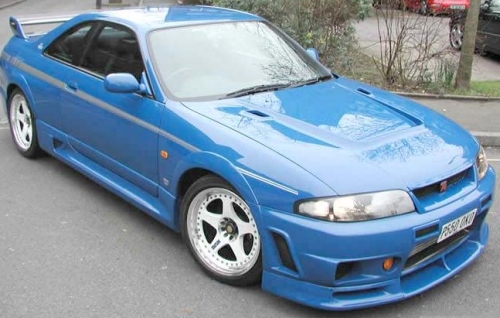
Special 400R edition R33 Nissan Skyline GT-R.
On November 3, 1997 a special edition R33 GT-R was released know as the 400R – “R” meaning “racing.” Developed by Nissan’s performance division Nismo, the 400R Skyline featured an overbored RB26DETT with polished ports, an upgraded exhaust system, composite parts, and a more free flowing turbo and intercooler system that raised horsepower to 400 and allowed the car a top speed of over 200 mph. The new 400 horsepower RB26DETT engine would be known as the RBX-GT2. The 400R also sports a more aerodynamic body kit and front spoiler, redesigned rear-wing, Nismo brakes, 18-inch wheels, and race-style bucket seats with harnesses.
- Drift Japan Fact – The Drift Japan logo is a R33 Nissan Skyline GT-R (see homepage).
Nissan RB26DETT Engine – The heart beat of the Skyline.

Nissan RB26DETT twin turbo engine and heart of the Skyline.
The Nissan RB26DETT is a 2.6L straight-6 four-stroke engine best known for being the power plant for Nissan’s premier sports car the Skyline. The “D” indicates a double overhead cam, the “E” stands for electronically fuel-injected, and the “TT” means the engine has twin turbochargers.
Originally, the R32 Skyline GT-R was planned to have a 2.4L RB24DET (single turbo) in order to compete in the 4000cc class of Group A. But when Nismo engineers added the AWD system to the R32 Skyline it made the car heavy and less competitive. At that point, Nissan made the decision to add twin turbochargers to the now 2.6L engine and compete in the 4500cc class. The resulting engine would be known as the RB26DETT that is popular today.
The first 2.6L RB26DETT engine featured in the Nissan R32 Skyline produced around 276HP (206 kW) @ 6800 rpm and 260 ft lbs (353 N·m) @ 4400 rpm. The last series of the RB26DETT present in the R34 Skyline produced 280 PS (206 kW) @ 6800 rpm but increased torque to 289 ft·lb (392 N·m) @ 4400 rpm.
These horsepower numbers appear modest at first but stock RB26DETT engines have been dyno tested close to the 320 horsepower mark. The reason some RB26DETT engines put out 320HP and others don’t is due to environmental restrictions. In Japan, every production car is restricted to 276HP. Therefore, Japanese versions of the engine put out 276HP and unrestricted or non-Japanese versions put out 320HP.
Aftermarket performance companies like HKS and Tomei sell parts like variable cams and pulleys for the RB26 that increase its tuning and performance potential. With extreme modification, the RB26 engine is capable of horsepower in excess of 1 megawatt or 1,340 horsepower.
The RB26DETT engine can be found in the following cars:
- Nissan Skyline GT-R R32
- Nissan Skyline GT-R R33
- Nissan Skyline GT-R R34
- Nissan Stagea 260RS
- Tommy Kaira ZZ II
Toyota Corolla AE86
The Toyota Corolla AE86 is a classic drift car suited to rally and drifting motorsports due to these attributes: Rear wheel drive limited slip differential configuration, low vehicle weight, good balance, a 5-speed manual gearbox, ventilated disc brakes, MacPherson strut style independent suspension in front and a four-link live axle with coil springs for the rear, stabilizer bars (sway bars) at both ends, and a relatively powerful and easy to tune 4-cylinder engine.

Classic JDM Toyota Corolla AE86 inspired by Initial D anime.
In Japan, these qualities made the AE86 popular with Japanese street racers named “Hashiriya,” who raced the AE86 in mountain passes, named “touges,” where the tight corners suited the AE86. Many car enthusiasts refer to the AE86 by its Japanese name “Hachi-Roku,” which translated literally means “eight-six.”

Japanese driver Ueo Katsuhiro drifting his Toyota AE86 D1GP drift car.
Japanese racing legend Keiichi “Drift King” Tsuchiya helped popularize the sport of drifting while driving the AE86. The AE86 continues to have a large fan base because the classic relatively inexpensive drift car is capable of competing against much newer, more expensive, and powerful sports cars like the Nissan Skyline and Silvia in D1 Grand Prix and Formula D drifting events.
There were two versions of the AE86 and two body styles. The versions are commonly known by their Japanese names “Zenki” (early model) and “Kouki” (later model). The Zenki was produced from 1983 until 1985 and the Kouki was produced from 1986 to 1987. The chassis remained the same throughout production with the only changes being aesthetic and minor strengthening of the transmission. The two body styles available are the coupe and hatchback. The coupe is generally thought of as being the stronger of the two and is slightly lighter and therefore is usually chosen for racing purposes.In Japan and Europe, the AE86 was available with a fuel-injected 4-cylinder twin-cam 1587cc 4A-GEU engine which was also used in the first-generation Toyota MR2 (AW11). The 4A-GEU engine had a power output of 130 PS (97 kW) and 103 ft·lbf (140 Nm) of torque standard from the Toyota factory.

Toyota Corolla AE86 engine.
In North America, a modified 4A-GEC engine was used to comply with California emissions regulations. Power was rated at 112 bhp (84 kW), and 100 ft·lbf (136 Nm) of torque.
The 4A-GE engines were equipped with T-VIS or Toyota Variable Induction System that improves the low-end torque of high-performance, small displacement four-stroke engines by changing the geometry of the intake manifold according to the engine rotation speed.
Models equipped with the 4A-GE engine received a 6.7″ rear differential, while other models equipped with the 4A-C engine received a smaller, weaker, 6.38″ rear differential. The AE86 SR5 (4A-C equipped) had an optional automatic transmission, though the GT-S model (4A-GE engine) only came with a standard 5-speed manual gearbox.

Interior of 1980’s Toyota Corolla right hand drive coupe.
In Japan, the DOHC 4A-GEU AE86 was offered in GT-APEX or GTV trims as the Corolla Levin or Sprinter Trueno, with SOHC 3A-U AE85 version sold in a variety of trims including SR and GT.
In North America, the top-spec DOHC 4A-GEC AE86 was sold as the Corolla GT-S and the lower-spec SOHC 4A-C AE86 was sold as the Corolla SR5, both versions sold with pop-up headlights only. Lower-spec American AE86 SR5 models used a smaller 4A-C SOHC engine, did not have optional LSD, and had rear drum brakes instead of disks.Euro spec models were sold as the Corolla GT with DOHC engines and fixed Levin-style headlights. The Middle East received the same basic model as the North American market, with pop-up headlights and the regulated 5 mph (8 km/h) bumpers.

Old school JDM 1984 Toyota Corolla AE86 Levin hatch back.
Toyota Corolla Levin GT APEX AE86 – Fixed Headlights
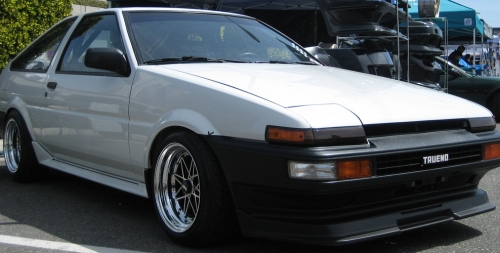
Vintage old school JDM Toyota Corolla AE86 Trueno.
Toyota Corolla Trueno AE86 – Pop-up Headlights
Both the Levin and Trueno AE86 variants were offered with either a 2-door coupe or 3-door liftback, or hatchback, body style. Both the Levin and Trueno were generally identical, apart from fixed, rectangular headlights on the Levin and pop-up headlights on the Trueno. Minor bodywork changes were made in 1986 which resulted in different tail lights for both Levin and Trueno models, along with the coupe and hatchback styles.
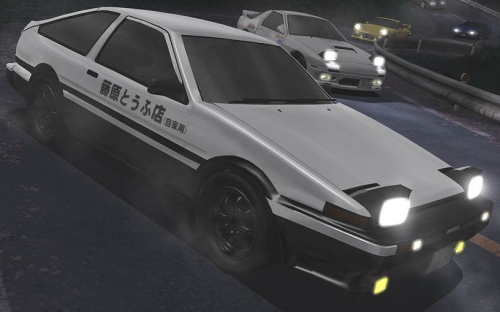
Scene from anime Initial D featuring the Toyota Corolla AE86.
The AE86 is frequently seen in Japanese manga and anime including Initial D, éX-Driver, Tenjou Tenge, Over Rev, Azumanga Daioh, Dear Boys, School Rumble, Capeta, Transformers: Energon, Jigoku Shojo, Jigoku Shoujo Futakomori, and [adult swim] hit FLCL. Manga appearances include Beck and Shuichi Shigeno’s earlier work Tunnel Nuketara Sky Blue.
Racing video games like: Namco’s The Fast and the Furious (PS2), Microsoft’s Forza Motorsport franchise, Electronic Arts’s Need for Speed franchise, and Sega’s Initial D Arcade Stage all feature the AE86 as a playable car.
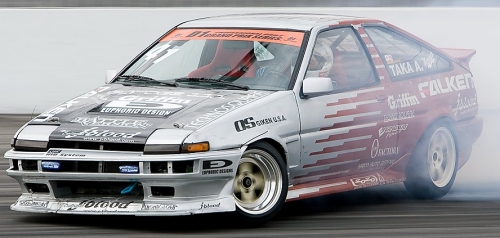
Japanese driver Taka Aono piloting his Toyota Corolla AE86 D1GP drift car.
More than 20 years after its production, the Toyota Corolla AE86 continues to play a roll in drifting and street racing. In modern day drifting, the AE86 is a classic under dog that continues to compete among drifting’s elite race cars. It is pretty impressive to see an AE86 hang with a Skyline during tsuiso battle.
History of the Toyota Supra
Toyota Celica Supra Mark I (1979-1981)
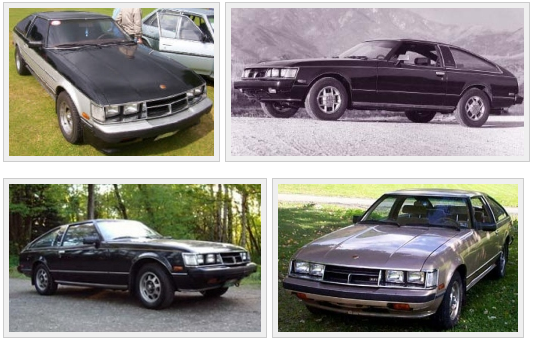
First generation Toyota Celica Supra Mark I 1979-1981.
The first generation Toyota Supra was largely based upon the Toyota Celica hatchback. The doors and rear section stayed the same length as the Celica, but rear panels were longer by 5.1 inches (129.5 mm). The most notable change was the swap to an inline-6 engine instead of the stock Celica’s 4-cylinder engine. Toyota’s original plan for the Supra was to make it a competitor to the popular Datsun, now Nissan, Z-car.
In Japan, Toyota began production of the Mark I Supra in 1978. In 1979, the Toyota Supra entered the North American automotive market. The US Supra Mark I came equipped with a 110 hp (82 kW) 2.6 L (2563 cc) 12-valve inline-6 4M-E engine. In Japan, the Supra Mark I (chassis code MA45) had a slightly modified 110 hp (82 kW) 2.0 L 12-valve inline-6 M-EU engine. Both Toyota engines were the first ever equipped with electronic fuel injection.
Drivetrain options for the Mark I were either a 5-speed manual or an optional 4-speed automatic transmission. The drivetrain for the Supra retained the T series solid rear axle configuration of the Celica in the Japanese MA45 version and a larger F series and optional Limited Slip Differential in the MA46 and MA47. The Supra also came standard with 4-wheel disc brakes and a four-link rear suspension with coil springs, lateral track bar, and stabilizer/sway bar. The front suspension consisted of MacPherson struts and a sway bar.
On the inside, the Supra had an option of power windows and locks as part of the convenience package. This package also included cruise control and special door trim with door pull straps and an optional sunroof. Standard features, include an extendable map light and a flip top armrest in the center console. Some other features were tilt steering wheel, deep zippered pockets on the backs of the front seats, and tonneau cover under the hatchback. The dashboard had a AM/FM/MPX 4-speaker stereo radio, analog clock, and tachometer as part of the instrument panel.
In 1980, the Japanese Mark I, also branded with the MA46 chassis code, was offered with a 145 hp (108 kW) 2.0 L (1988 cc) 12-valve turbocharged inline-6 M-TEU engine. The engine was equipped with a Garrett T03 Turbo, but was not intercooled. The M-TEU engine was the first Toyota engine to utilize a turbocharger.
Most of the changes for the 1980 US Supra were mostly cosmetic. The interior received a redesigned center console and a digital quartz clock. The exterior had redesigned side view mirrors and now standard 14×5.5 aluminum rims (optional in 1979). Body molded mudflaps with the word “Celica” painted in white lettering were also available. On the copper metallic and white Supras, the mudflaps were painted the body color while the mudflaps were left black on all other colors. There was also an optional of leather-trimmed seas and automatic climate-control.
In 1981, the Supra received an upgrade in displacement with the 2.8 L (2759 cc) 5M-E engine. The new 2.8L engine makes 116 hp (87 kW) and 145 ft·lbf (197 N·m) of torque. The cars automatic transmission was changed to the revised Toyota A43D and gained a revised final drive gearing. Because of the change in engine and transmission, a new chassis code of MA47 was made. The final year MK I Supra achieved a 0-60 MPH time of 10.24 seconds and finished the 1/4 mile in 17.5 seconds at 77.7 MPH.
Also in 1981, a new Sports Performance Package became an option, which included sport suspension, raised white letter tires, and front and rear spoilers. This also marked the last year that the 8-track cartridge was offered in any Supra.
Engine
- 2.0 L (1988 cc) M-EU I6
- 2.0 L (1988 cc) M-TEU I6
- 2.6 L (2563 cc) 4M-E I6
- 2.8 L (2759 cc) 5M-E I6
Transmission
- 5-speed W50 manual
- 4-speed A40D automatic
- 4-speed A43D automatic
Chassis
- Platform MA4x
- Wheelbase 103.5 in (2628.9 mm)
- Length 181.7 in (4615.2 mm)
- Width 65.0 in (1651.0 mm)
- Height 50.8 in (1290.3 mm)
- Curb weight ~2800 lb (1270.1 kg)
Fuel capacity 16.1 U.S. GAL (60.4 L)
Toyota Celica Supra Mark II (1982-1986)

Toyota Celica Supra Mark II manufactured 1982-1986.
In 1982, Toyota completely redesigned the Celica Supra as well as the entire Celica lineup. In Japan, they were known as Celica XX, but everywhere else the Celica Supra name stuck. Still based around the Celica platform, there were several key differences most notably in the design of the front end and fully retractable pop-up headlights, inline-6 engine, and increased overall length and wheel base designed to match the larger engine.
P-type and L-type
In the North American market, the Celica Supra was available in two distinct models. The Performance Type (P-type) and the Luxury Type (L-type). While being mechanically identical, they had different available options like tire size, wheel size, and body trim.
The P-type had fiberglass fender flares over the wheel wells, while the L-type did not. The P-type was also standard with the more sporty 8-way adjustable seats. The P-type did not get the option of leather seats until 1983. All editions of the P-Type had the same 14×7 aluminum alloy rims and throughout the years the L-Type had 14″x5.5″ rims until 1985 when they were changed to a P-type style 15×6. The L-type also had the option of a digital dash with trip computer, whereas the P-Type was only offered with an analog dash and digital clock. The digital dash featured a digital tachometer, digital speedometer, and electronic fuel level and coolant level gauges. The trip computer could calculate and display various things such as fuel economy in miles-per-gallon, estimated time of arrival (ETA), and distance remaining to destination. Excluding the 1982 model, all P-types were available with headlight washers as an option, but the L-types were never fitted with such an option. Although gear ratios changed throughout the years all P-types came standard with a limited slip differential (LSD).
In the 1982 North American market, the Celica Supra’s engine was the 2.8 L (2759 cc) 12-valve (2 valves per cylinder) DOHC 5M-GE. Power output was 145 hp (108 kW) and 155 ft·lbf (210 N·m) of torque. The engine utilized an 8.8:1 compression ratio to achieve the power and featured a vacuum advanced distributor. When the car debuted it clocked a 0-60 time of 9.8 seconds and netted a 17.2 second 1/4 at 80 MPH.
The standard transmission for this year was the W58 5-speed manual with the A43DL 4-speed automatic transmission being an option for L-types. Both transmissions featured an overdrive gear and the automatic featured a locking torque converter. The top gear in the 5-speed was its overdrive whereas the automatic transmission featured an overdrive gear that would engage at speeds over 35 mph. The 1982 models’ rear differential featured a 3.72:1 ratio. The Celica Supra’s 4-wheel independent suspension was specially tuned and designed by Lotus and featured variable assisted power rack-and-pinion steering and MacPherson struts up front. As for the rear, it had semi-trailing arm suspension with coil springs and a stabilizer bar. Braking on the Celica Supra was handled by 4-wheel disc brakes.
On the inside this generation had standard power windows, power door locks, and power mirrors as well as a tilt steering wheel. The power door lock was located in the center console next to the power mirror control. The analog dash of this year only went to 85 mph in North America. The optional automatic climate control on the MK I was renovated and was now seen as a standard feature on the MK II. Cruise control was standard in this generation. Toyota also included the retractable maplight as standard, just like with MK I Supras. Some options included the addition of a sunroof, two-tone paint schemes, and 5-speaker AM/FM/MPX tuner with cassette. The optional cassette stereo featured a 105-watt power amplifier and a 7-channel graphic equalizer to control tone. The standard stereo was a 5-channel AM/FM/MPX tuner. Leather was an option on L-Types this year, but P-types were stuck with standard striped cloth.
As far as the outside goes there was no external antenna it was simply located in the front windshield. There was a key lock on the gas tank door and the hatch and bumpers were black no matter what color the rest of the car was. The P-types were available with an optional rear sunshade above the hatch glass. The lights in the rear featured a reverse light in the center and the door handles opened the doors by pulling sideways. The front nose badge and B-pillar only read “SUPRA”. Although it is believed mudflaps weren’t introduced on this generation until 1983, all L-types had front and rear mudflaps.
For the 1983 models not much was altered, but there was an increase in power output to: 150 hp (112 kW) and 159 ft·lbf (216 N·m) of torque from the same 5M-GE. The only real change in the engine area was the switch to an electronic advanced distributor, yet that did not increase power. Toyota switched to a 4.10:1 rear gear ratio for the P-Type and a 3.73:1 for the L-Type. As for the optional automatic transmission they switched out the A43DL 4-speed for a newly designed A43DE 4-speed. It featured an electronic controller that would adjust its shift pattern for a balance between performance and economy. It was the first in the industry to provide an “Electronically Controlled Transmission” (ECT). This allowed the driver to choose either the “Power” driving mode or “Normal” driving mode at the touch of the button. The “Power” mode provided the quickest acceleration and the “Normal” mode provided the best all-around performance.
On the inside of the car there were virtually no changes, but on the outside they decided to switch to a power antenna and it was the first year both the P-Type and L-Type had standard mudflaps. The B-pillar and nose badge were changed to say “Celica Supra” now and only L-Types were available in two-tone color schemes.
In 1984, Toyota changed quite a bit on the Supra. Power output was increased on the 5-speed models with a bump up to 160 hp (119 kW) and 163 ft·lbf (221 N·m) of torque. The increase was achieved by a mixture of a redesigned intake manifold with “D”-shaped intake runners and an increase in compression ratio to: 9.2:1
Other changes would be a redesigned, more “integrated” sunshade and spoiler on the rear hatch. The rear spoiler was changed from a one piece to a two piece spoiler. Oddly the L-types of this year were not available with a leather interior, but P-types were. Toyota added a standard factory theft deterrent system and the outside mirrors were equipped with a defogger that activated with the rear defroster. All Supras this year received automatic-off lights that also encompassed an automatic illuminated entry and fade-out system.
While 1985 was to be the last year of the second generation model, delays in production of the third generation model led to a surplus of second generation Supras. During the first half of 1986 the 1985 MK II P-type was still offered for sale, with only minor cosmetic changes as well as the addition of a now mandatory rear-mounted third brake light on the hatch. These were all labeled officially as 1986 models. P-types were the only model available in 1986.
MK IIs around the world
The second generation Supra came in a variety of options around the world as well as only being offered during select years.
Europe – Sold from 1982-1986.
- 82-83: 2.8 L (2759 cc) DOHC 5M-GE 174 hp (130 kW) and 207 ft·lbf (287 N·m) of torque. Analog dash, no fender flares.
- 84-86: 2.8 L (2759 cc) DOHC 5M-GE 178 hp (133 kW) and 212 ft·lbf (281 N·m) of torque. Digital dash, P-Type fender flares.
Great Britain – Sold from 1982-1986.
- 82-83: 2.8 L (2759 cc) DOHC 5M-GE 178 hp (133 kW) and 212 ft·lbf (281 N·m) of torque. Analog dash, no fender flares.
- 84-86: 2.8 L (2759 cc) DOHC 5M-GE 178 hp (133 kW) and 212 ft·lbf (281 N·m) of torque. Digital dash, P-Type fender flares.
Australia, Sweden, & Switzerland – Sold from 1984-1986.
- 2.8 L (2759 cc) SOHC 5M-E 116 hp (87 kW) and 145 ft·lbf (197 N·m) of torque.
In Australia, the Toyota Supra manufactured between 1982-1990, was assessed in the Used Car Safety Ratings 2006 as providing “worse than average” protection for its occupants in the event of a crash.
The 1984 Supra in Australia had a digital dash, fender flares, 82-83 style lights, one single piece spoiler and no sunroof.
New Zealand – Sold from 1984-1985
- 2.8 L (2759 cc) DOHC 5M-GE 178 hp (133 kW) and 212 ft·lbf (281 N·m) of torque. Digital dash, P-Type fender flares.
Engine
- 2.0 L (1988 cc) M-TEU I6
- 2.0 L (1988 cc) M-TE I6
- 2.0 L (1988 cc) 1G-EU I6
- 2.0 L (1988 cc) 1G-GEU I6
- 2.8 L (2759 cc) 5M-E I6
- 2.8 L (2759 cc) 5M-GE I6
Transmission
- 5-speed W58 manual
- 4-speed A43DL automatic
- 4-speed A43DE automatic
Chassis
- Platform MA6x, GA6x
- Wheelbase 102.9 in (2613.7 mm)
- Length 183.5 in (4660.9 mm)
- Width 67.7 in (1719.6 mm)
- Height 52.0 in (1320.8 mm)
- Curb weight ~3000 lb (1360.8 kg)
Fuel capacity 16.1 U.S. GAL (60.4 L)
Toyota Supra Mark III (1986 1/2-1992)

Third generation Toyota Supra 1986-1992.
In the middle of 1986, Toyota was ready to release its next version of the Supra. The official model year is designated as 1986.5. The bonds between the Celica and the Supra were now severed. The Celica changed to front wheel drive, while the Supra kept its rear wheel drive platform. Though the Mark II and Mark III had similar designs, the engine was updated to a more powerful 3.0 L straight 6. Although only available in naturally aspirated trim in 1986.5, a second version of the engine was introduced in 1987 which featured a turbocharger.
The new Mark III Supra engine was now Toyota’s flagship engine. Both versions of the engine contained 4 valves per cylinder and dual overhead cams. The turbocharged 7M-GTE engine was Toyota’s first distributor-less engine offered in the U.S. and was rated at 232 hp (173 kW) at 5600 RPM while the naturally-aspirated 7M-GE engine was rated at 200 hp (149 kW) at 6000 RPM.
The naturally aspirated came standard with the W58 manual transmission. The turbo versions included the more robust R154 manual transmission. Both were available with the optional 4-speed A340E automatic transmission.
During the year of 1989, the car received new tail lights, new front bumper, badging and side trim among other features. Modifications to the wastegate and engine management netted another 2 hp on the turbo model. For the 1991 model year, the wheel design was changed to 5-spoke wheels. Both models wore 16×7 aluminum alloy wheels that were fitted with 225/50/16 tires and full-sized spares on steel wheels.
The A70 Supra was also available in two non-export models in Japan, the JZA70 with a 2.5 L 280 hp (209 kW) twin-turbo 1JZ-GTE, known as 2.5GT Twin Turbo (JZA70), and with a 2.0 L 210 hp (157 kW) twin-turbo 1G-GTE. A special version of the 1JZ-GTE equipped JZA70, the 2.5 Twin Turbo R, had black/grey Recaro seats.
The third-generation Supra represented a great deal of new technology. In 1986, Supras were already equipped with 4-channel ABS and TEMS (Toyota Electronically Modulated Suspension) which gave the driver 2 settings which affected the damper rates. All models were fitted with double wishbone suspensions front and rear. A targa top was offered along with a metal power sliding sunroof (added in 1991).
The 7M-GTE MA70 is capable of propelling itself 0-60 mph in 6.2 seconds with 6.8 psi of boost. It reached the 1/4 mile in 14.7 seconds at a speed of 95 mph. Its top speed is 149 mph.
Toyota Supra Turbo-A
In 1988 the Turbo-A model was introduced. It was a special design aimed at winning the Group-A touring car championships around the world. There were only 500 Turbo-As ever made. The Turbo-A was a special 7M-GTE with 267 PS (263 hp/196 kW), making it the fastest Japanese road car until the Nissan Skyline R32-GTR was introduced. The Turbo-A model was only produced in black, featured a grey leather interior, a larger intercooler, and used speed/density (MAP + IAT sensor) air metering. In addition, it was a hardtop model and featured a larger compressor wheel on the CT-26 turbocharger and throttle body.
Engine
- 2.0 L (1988 cc) 1G-GTE I6
- 2.5 L (2491 cc) 1JZ-GTE I6
- 3.0 L (2954 cc) 7M-GE I6
- 3.0 L (2954 cc) 7M-GTE I6
Transmission
- 5-speed W58 manual
- 5-speed R154 manual
- 4-Speed A340E automatic
Chassis
- Platform MA7x, GA7x, JZA7x
- Wheelbase 102.2 in (2595.9 mm)
- Length 182.3 in (4630.4 mm)
- Width 68.7 in (1744.9 mm)
- Height 51.2 in (1300.5 mm)
- Curb weight ~3500 lb (1587.6 kg)
Fuel capacity 18.5 U.S. GAL (70.0 L)
Toyota Supra Mark IV (1993-2002)

Toyota Supra Mark IV manufactured 1993-2002.
With the fourth generation of the Supra, Toyota took a big leap in the direction of a more powerful sports car. The new Supra was completely redesigned, with rounded body styling partly based on the Ferrari F40 and featured two new engines: naturally aspirated 2JZ-GE 220 hp (164 kW) and 210 ft·lbf (285 N·m) of torque and a twin turbocharged 2JZ-GTE making 276 bhp (239 kW), 260 ft·lbf (427 N·m) of torque. The Turbo was actually quoted to have 320 bhp, as the cars in the Japan market can only declare up to 276. The turbocharged variant could achieve 0–60 mph in as low as 4.6 seconds and 1/4 mile (402 m) in 13.1 seconds at 109 mph. The turbo version was tested to reach over 289 kph (180 mph) all-stock, but the cars are restricted to just 180 kph in Japan and 250 elsewhere. European versions had an air intake on the bonnet.
The MKIV Supra’s twin turbos operated in sequential mode instead of the more common parallel mode. The sequential setup featured a pair of small, equally sized turbos, with ceramic blades for the domestic Japanese market and steel blades for export (USA, Europe) markets. At first, all of the exhaust is routed to the first turbine for reduced lag. This resulted in boost and enhanced torque as early as 1800 rpm. Approaching 4000 rpm, the exhaust is routed to the second turbine for a “pre-boost” mode, although none of the compressor output is used by the engine at this point. Approaching 4500 rpm, the second turbo’s output is added to the intake air, and both turbos operate in parallel. Most cars which are advertised as “twin turbo” operate by having the two equally sized turbos constantly running in parallel; the turbos spool up at the same time. The sequential mode provides greater low-end response at the expense of increased complexity and cost.
For this generation, the Supra received a new 6-speed Getrag gearbox on the Turbo models while the naturally aspirated models made do with a 5-speed manual. Both models were offered with a 4-speed automatic with a ‘manumatic’ mode. However, the turbo model utilized larger 4-piston brake calipers on the front and 2-piston calipers for the rear. The base model used smaller 2-piston calipers for the front and a single piston caliper for the rear. The turbo models were fitted with 235/45/17 tires on the front and 255/40/17 tires for the rear. The base model used 225/50/16 for the front and 245/50/16 for the rears. All vehicles were equipped with 5-spoke aluminum alloy wheels and a “donut” spare tire on a steel wheel. Additionally, there are other differences in the rear axle differential, headlight assemblies, throttle body, oil cooler and a myriad of additional sensors that exist on the turbo model which doesn’t exist on the normally aspirated model.

Manabu Orido’s RS-R sponsored Toyota Supra D1GP drift car.
Toyota took measures to reduce the weight of the current model compared to the previous model. Aluminum was used for the hood, targa top (if equipped), front crossmember, oil and transmission pans, and the suspension upper A-arms. Other measures included dished out head bolts, hollow carpet fibers, magnesium steering wheel, plastic gas tank and lid, gas injected rear spoiler, and a large single exhaust tip. Despite having more features such as dual airbags, traction control, larger brakes, larger wheels, larger tires, and an additional turbo, the car was at least 200 lbs lighter than its predecessor.
For the 1996 model year, the turbo model was only available with the automatic transmission due to OBD2 certification requirements. The targa top was made standard on all turbo models. For 1997, the manual transmission is back for the optional engine along with a redesign of the tail lights, front fascia, chromed wheels, and other minor changes such as the radio and steering wheel designs. All 1997 models included badges that said, “Limited Edition 15th Anniversary.” For 1998, the radio and steering wheel were redesigned once again. The naturally aspirated engine was enhanced with VVTI which raised the output by 5 hp and 10 ft·lb of torque. The turbo model was not available in California, New Jersey, New York and Massachusetts due to increased emission regulations.
The stock MKIV Supra chassis has also proven an effective platform for road racing, with several top 20 and top 10 One Lap Of America finishes in the SSGT1 class. The major deficiencies with this platform for road racing include heat management and weight due to the 2JZ iron block. The Supra is one of the heaviest 2-door Japanese sports cars, however still slightly lighter than the Nissan R33 and R34 Skyline GTRs to which the Supra is traditionally a rival in its home country.
Due to the strength of the stock engine the 2JZ series have remained popular import platforms for modification. Stock engine hardware have withstood power levels in excess of 3 times the original power ratings. In drag racing, the Supra and similarly powered 2JZ cars have run competitively against domestics vehicles with up to three times the engine displacement.
Sales to Canada were stopped in 1995 and US imports ceased in 1998. Production continued in Japan until August 2002.
Engine
- 3.0 L (2997 cc) 2JZ-GE I6
- 3.0 L (2997 cc) 2JZ-GTE I6
Transmission
- 5-speed W58 manual
- 6-speed V16x manual
- 4-Speed A341E automatic
Chassis
- Platform JZA8x
- Wheelbase 100.4 in (2550.2 mm)
- Length 177.7 in (4513.6 mm)
- Width 71.3 in (1811.0 mm)
- Height 50.2 in (1275.1 mm)
- Curb weight
- non-turbo: 3210 lb (1460 kg)
- turbo: 3478 lb (1580.9 kg)
Fuel capacity 18.5 U.S. GAL (70.0 L)
Assembly Motomachi, Japan.
Toyota Soarer
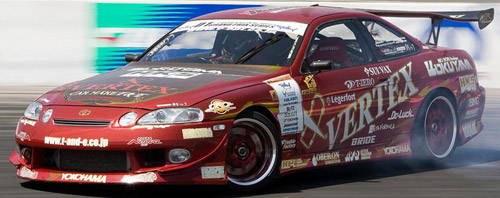
Vertex JZ powered Toyota Soarer initiating drift D1GP.
The Toyota Soarer is a two-door luxury coupe sold only in Japan from 1981 until 2004. The Soarer replaced the Toyota Crown Coupe and is closely related to the Lexus SC 300/400. There are four distinctive series of Soarers all with FR layouts (front engine and rear wheel drive), thus making them suitable for drifting. The early model Soarers closely resemble Nissan S110 Silvia, but the later Soarers take on a personality of their own and share the powerful JZ engine present in the Toyota Supra. Currently, Japanese drifter Takahiro Ueno is driving a Soarer in D1 Grand Prix.
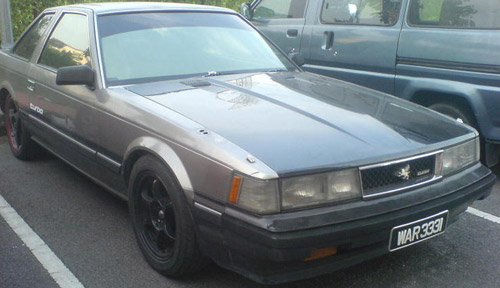
First generation vintage JDM Toyota Soarer Z1.
The first Toyota Soarer debuted in 1981 known as the Z1 series and was honored as Japan’s Car of the Year for the 1981 and 1982 model years. The Z1 series Toyota Soarer was produced from 1981 to 1985 and featured numerous technological novelties like a touch screen computer controlled air conditioning unit and a LED digital speed and tachometer display. The Z1 Soarer also came with self-diagnosis maintenance reminders.
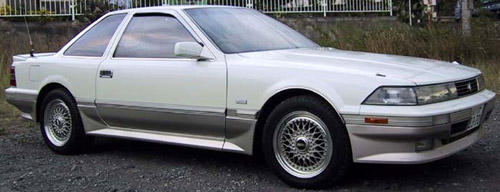
Second generation white Toyota Soarer Z2.
The second generation Z2 series Toyota Soarer was produced from 1986 to 1991 and featured styling similar to the MX73 Toyota Cressida, GX71 Toyota Mark II, and even the Nissan S110 Silvia. The Z2 Soarer shares the same platform as the Toyota Supra.
The Z3 or 30 series Toyota Soarer features a rounded body style and was produced from 1991 to 2000. Outside of Japan the 30 series Soarer would be know as the Lexus SC 300/400. Although the Soarer and SC 300/400 share the same body style, but they have different options.
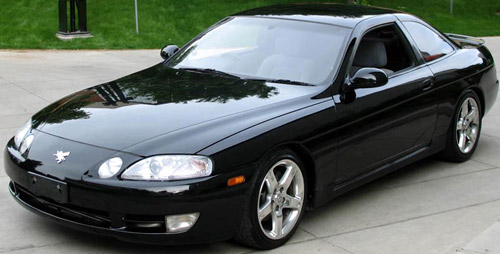
Black Toyota Soarer Z3 coupe.
At the time of the Z3’s launch it was one of the first cars ever to feature factory GPS navigation. The technology employed rivaled that of cars twice the price. The Z3 continued to share the same chassis, suspension, brakes, drivetrain, and engine parts as the MKIV Toyota Supra.
In Japan between 1991 and 1996 the Soarer was only available with the 1JZ-GTE 2.5L twin turbo engine until August 1996 when a single turbo engine with variable valve timing was introduced. The single turbo engine had the same horsepower but increased low-end torque. The 1996 model also received minor cosmetic changes to the bumpers and side skirts.

The latest rendition of Toyota’s Soarer is the Lexus SC430 coupe.
In 2001, Toyota introduced the forth and final generation of the Soarer known as the 40 series in Japan and the Lexus SC 430 worldwide. In 2005, Toyota introduced the Lexus brand to Japan and subsequently discontinued the Soarer. The debut of the Lexus SC 430 in Japan signaled the end of the Toyota Soarer.
Mazda RX-7
The Mazda RX-7 is an excellent drift car because of its rear wheel drive limited slip differential configuration, near perfect 50-50 weight distribution, light weight, powerful twin turbo 13B-REW rotary engine, low center of gravity, and sport tune suspension.

Apex sponsored Mazda RX-7 D1GP drift car.
Youichi Imamura drove the A’PEXi sponsored Mazda RX-7 FD3S to a championship win during the 2003 D1 Grand Prix Season. Although all three generations of the Mazda RX-7 can drift, the FD or third generation is the most popular RX-7 for drifting. Within the FD generation, there are three series of RX-7s:
- Series 6 (1992 – 1995) This is the only group of the RX-7 FDs sold in North America. In Japan, Mazda sold the 6 Series RX-7 under its Efini brand name as the Efini RX-7. Series 6 came with 230hp and 200ft-lbs.
- Series 7 (1996 – 1998) All 7 series RX-7s are right-hand-drive. In Japan, Mazda decided to sell the 7 Series RX-7 under the Mazda brand name instead of Efini. The Series 7 was sold in Japan, Australia, New Zealand and the UK. Updates include a simplified vacuum routing manifold and a 16-bit ECU that increased boost and gave the rotary engine an extra 10 horsepower.
- Series 8 (January 1999 – August 2002) The 8 series RX-7 was the final RX-7 built by Mazda and was only available in Japan. More efficient turbochargers and a revised engine bay allowed for improved intercooler and radiator cooling. The seats, steering wheel, front and rear lights were all changed and an adjustable rear wing was added.
The Series 8 RX-7 had 3 variants. “Type RS” came equipped with Bilstein suspension, 17″ wheels, and a reduced vehicle weight to 1280 kg (2822 lbs). Power was officially claimed as 250 ps (276 hp, 208 kW) to satisfy Japanese horsepower limits although, realistic power is closer to 220 or 230 kW (290–308 hp). The “Type RZ” variant included all the features of the Type RS, but boasted an even lighter vehicle weight of 1270 kg (2800 lbs). It also featured custom gun-metal BBS wheels and a custom red racing themed interior. Further upgrades included a new 16-bit ECU and ABS system upgrades.
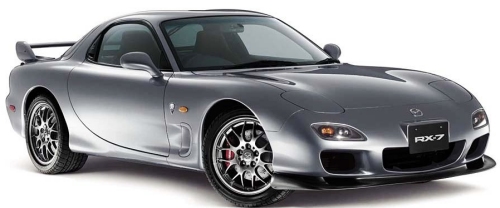
Special Spirit R edition 2002 Mazda RX-7 coupe.
The most collectible RX-7s are the last 1,500 built. Dubbed the “Spirit R”, these RX-7s combined all the additional features Mazda had used on previous limited-run specials. All 1,500 Spirit RX-7s sold within days of being announced and they still command amazing prices in the Japanese used car market.
In Japan, the RX-7 has been a popular choice for racing teams. In 2006, the RE Amemiya Racing AsparaDrink RX-7 FD3S won the Super GT300 class championship.
The RX-7 has appeared in the Japanese anime series, Initial D, driven by both Takahashi brothers – Keisuke and Ryosuke, Keisuke driving a yellow twin-turbo FD3S and Ryosuke driving a white FC3S. Also Kyoko, the girl that likes Keisuke, drives a black single turbo RX-7 FD3S.
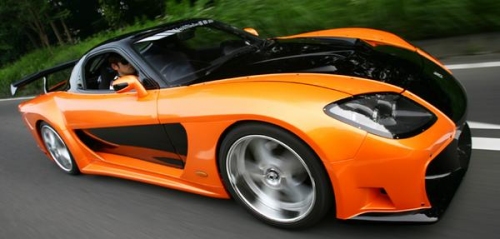
VeilSide modified 1997 Mazda RX-7 featured in Fast and the Furious: Tokyo Drift movie.
The RX-7 FD has also been featured in every film in the Fast and the Furious franchise. In the latest Fast and Furious Tokyo Drift, a highly modified Veilside RX-7 was featured as one of the stars. Veilside built three duplicate RX-7s for the film while the Tokyo Drift shop built three visual clones — including one destined for destruction using a Mazda RX-7 that appeared in both previous Fast and Furious films as its base.
The RX-7 was Motor Trend’s Import Car of the Year in 1986 and 1993. When Playboy magazine first reviewed the FD RX-7 in 1993, they tested it in the same issue as the Dodge Viper and declared the RX-7 to be the better of the two cars.A popular modification to the RX-7 FD is a Mazda 20B engine swap. The main difference between the 13G and 20B is that the 13G uses a factory peripheral intake port and the 20B uses side intake ports. Besides that, the 20B is a 2.0L 3-rotor engine only used in the 1990-1995 Eunos (Mazda) Cosmo. The 20B 3-rotor configuration can produce up to 550 horsepower and a top speed over 200 mph with aftermarket performance parts. Still, RX-7 enthusiasts maintain that the 13B engine can achieve the same level of performance as the 20B, but the difference is in reliability since the 20B engine can handle the higher horsepower more effortlessly.
Mazda MX-5 Miata
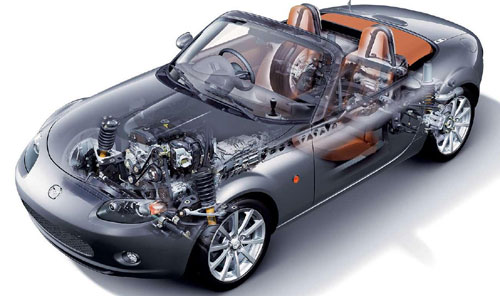
Phantom view of a 2005 Mazda MX-5 roadster revealing engine, transmission and suspension components.
The Mazda MX-5 is a Japanese two door convertible roadster known as the Mazda Miata in North America and the Eunos Roadster in Japan. Lightweight, good balance, and a FR layout make the MX-5 an ideal car for autocross and drifting. Currently there are three generations of the MX-5: NA (1989–1997), NB (1998–2005), and NC (2006-Present).
The first NA generation Mazda MX-5, also referred to as M1, started off with a 120 horsepower (90kW) 1.6-liter straight 4 cylinder B6P engine from 1989-1993 and was upgraded to a 130 horsepower (97kW) 1.8-liter BP engine from 1994-1997. Perhaps the easiest way to identify a NA model is by its pop-up headlights.
The body of the NA is steel with an aluminum hood. Independent double wishbone suspension at all four corners and sway bars at the front and rear stiffen the ride while cornering and four wheel-disc brakes bring the MX-5 to a stop.
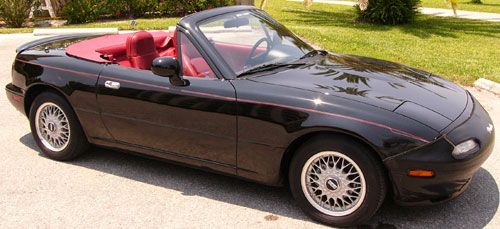
Japanese import first generation 1993 Mazda Miata MX-5 convertible coupe.
In 1993, 1500 Limited Edition (LE) MX-5s were built featuring a red leather interior, upgraded stereo, Nardi shift knob, leather wrapped steering wheel, cruise control, limited slip differential, power windows, power mirrors, power steering, air conditioning, BBS 8.5 lb wheels, Bilstein shocks, front and rear spoilers, ABS brakes, stainless sill plates, and all limited edition cars came in black paint.
1994 introduced the more powerful 1.8-liter engine, dual airbags and a geared, torque-sensing limited slip differential. In order to meet new side-impact safety standards, the chassis was substantially reinforced by adding a “track bar” between the seat belt towers inside the car and by strengthening the front and rear subframes. 1994 was the only year Mazda offered a metallic “Laguna Blue Mica” paint.
1994 also saw the introduction of the sportier R (Racing) package that removed all unnecessary parts like power windows to lighten the car and featured Bilstein shocks and subtle underbody spoilers to increase down force. Even though no body style changes were made to this model, sometimes it’s called the NA Generation 1.5 or even M1.5.

Le Mans Special Edition Mazda Miata.
The 1996 model gained 4 horsepower but the extra power is nullified by an increase in weight. Some markets like Japan and Europe continued to offer the 1.6 engine as a lower cost option, but it was detuned to 88 horsepower (66 kW).
There are various trim levels and special editions available in the NA generation MX-5. In the UK a special edition was created to celebrate Mazda’s 24 hours of Le Mans win. The special edition MX-5 features the paint scheme from the winning Mazda 787B race car and comes equipped with a BBR (Brodie Brittain Racing) turbo kit. This is one of the most sought after MX-5s for collectors.
The second NB generation Mazda MX-5 was introduced in 1998 and was the first MX-5 to feature fixed headlights. Other modifications include a slight increase in horsepower, a slightly wider wheelbase, a glass rear window, larger sway bars front and rear, and improved wheel, tire, and brake options.
The engine remained 1.8 liters, but an increased compression ratio, a solid lifter design with stronger cam, straightened intake runners in the head, and mounting the intake manifold higher increased horsepower to 140 (105 kW) and 119 ft lbs (161 Nm) of torque. The 1.6-liter engine continued as an option in Europe and Japan.
In 1999, Mazda released a limited edition 10th Anniversary MX-5 featuring a six-speed transmission and Bilstein shocks. Acceleration slightly improved, but top speed was lower than the standard 1.8 NB.
The 2001 MX-5 featured minor exterior changes, a new instrument panel with white face and red numbers, upgraded seats, and a stiffer chassis. The top model MX-5 featured 16-inch wheels, low-profile tires, and larger brakes front and rear. Small modifications to the 1.8 BP-Z3 engine and minor improvements to the intake and exhaust system boosts power to 155 horsepower (117 kW) for Japanese and Australian models.
In North America and Europe a controversy arose when Mazda quoted the power output for the JDM model (155 hp) instead of the local market model (146 hp/110kW). Mazda offered to buy back the cars due to the misleading power claims. Owners who did not participate in the buy back were offered an apology and free servicing for the warranty period.
In 2002, a small number of turbocharged MX-5s were developed and sold in Australia. The turbocharged MX-5 was known as the MX-5 SP and produced 210 horsepower (157 kW). Only 100 of these cars were built.
As an effort to target younger drivers in 2003, Mazda introduced the Shinsen Version, “Shinsen” meaning “Fresh and New” in Japanese. The MX-5 Miata SV features cruise control and aluminum trim like the more expensive LS model.

2004 Mazda MX-5 Mazdaspeed Trim package with six-speed transmission.
2004 was the first year for a production turbocharged MX-5. Known as the Mazdaspeed MX-5 Miata in the States, and the Roadster Turbo in Japan, it features an IHI turbocharger producing 178 horsepower (133 kW), front-mounted intercooler, tuned suspension, upgraded transmission and clutch assemblies, upgraded drivetrain components, Racing Hart 17-inch alloy wheels, and special interior trim. The 2004 Mazdaspeed MX-5 was available in Velocity Red Mica and Titanium Gray Metallic while the 2005 model was available in Lava Orange Mica and Black Mica. In Japan, 350 convertible hardtop Roadster Coupes were built.
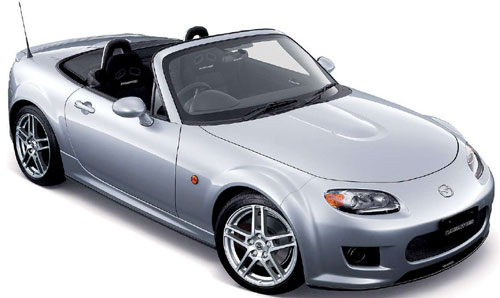
Silver 2005 Mazda MX-5 roadster convertible Japanese import.
The third NC generation MX-5 introduced in 2005 continued with the fixed headlamps and is recognizable by the fender bulges over the wheel wells. The NC offers a wider range of options for customization than the earlier MX-5 generations. To promote the launch of the NC model, 3500 “3rd Generation Limited” edition MX-5s with added chrome trim and special wheels were built and delivered in advance of standard models.
A new 2.0-liter 16 valve straight 4 cylinder MZR engine producing 170 horsepower (128 kW) and 140 ft lbs (190 Nm) of torque is now under the hood. Transmission options include a 5-speed or 6-speed manual transmission or a six-speed automatic transmission with paddle shifters. A limited slip differential is an option with the 6-speed transmission.In Europe there are two engine options. The same 2.0 MZR engine, but rated at 160 horsepower (118 kW) and 138 ft lbs (188 Nm) of torque with the 6-speed manual transmission; and the new 1.8 MZR engine rated at 126 hp (93 kW) and 123 ft lbs (167 Nm) of torque with the 5-speed manual transmission.
Suspension has changed from independent double wishbone suspension at all four corners to a front wishbone/rear multi-link setup. Traction and stability control electronics were added to increase handling capabilities.

Blue Mazda MX-5 convertible with power retractable roof.
Mazda unveiled a folding hard top variant of the NC in 2006, named the “MX-5 Roadster Coupe” in Europe, “Roadster Power Retractable Hard Top” in Japan, and “MX-5 Miata Power Retractable Hard Top” in North America. The hard top option added 79 lbs (36 kg) of weight compared to the soft top.
In 2008, Mazda produced 750 Special Edition MX-5s exclusively for the US in Icy Blue paint, Saddle Brown folding top, matching leather interior, silver accented shift knob, dark-silver finished instrument panel with chrome accents, special 17-inch alloy wheels, stainless steel MX-5 scuff plate, and chrome front headlight bezel, grill and fog lamp surround.





















































